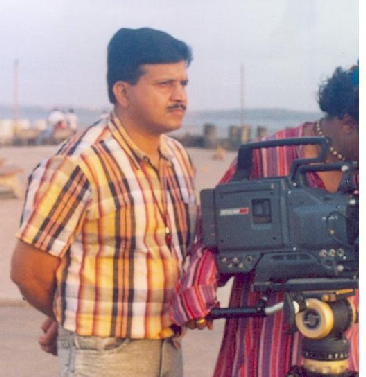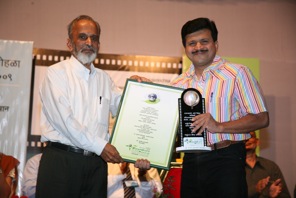Jagdish Kulkarni
Subtitling and dubbing in India
Portal 7 interviewed Jagdish Kulkarni, Marathi producer of environmental films in India
© Raquel Ruiz & Michaela Fisnar-Keggler, 2010
Jagdish Kulkarni is working at YCM Open University, Nashik, as a technician and video producer. He is the Director of 11 TV serials, more than 300 documentaries and educational TV programmes, hundreds of TV commercials, multi camera shooting for events in India and abroad, and responsible for over 30 environmental films.

The Marathi people or Maharashtrians are an Indo-Aryan ethnic group, that inhabit the Maharashtra region and state of western India. Their language Marathi is part of the southern group of Indo-Aryan languages. The state Maharashtra is located in South West India. It is the second most populous and third largest state by area in India.
Raquel: India has the world's second largest movie industry, churning out around one thousand movies each year. It is witnessing marked improvements in all areas – from the technology to the financing and marketing. What is the percentage of Indian films subtitled as opposed to those dubbed for their distribution abroad?
Jagdish Kulkarni: Normally, all Hindi films now come with a DVD option of English subtitles. Of the thousand films that India produces per year, around 250 are Hindi, 100 are Marathi and around 600 films in South Indian languages. (The three major ones are Telgu, Tamil and Kannada.)
A few South Indian films are dubbed in Hindi with English Subtitles and some Hindi films are dubbed in South Indian languages.
Hollywood movies are also very popular in India and nearly always dubbed in Hindi. Multiplex theatres generally show both the English and Hindi version. Due to popular demand these films are also dubbed in South Indian languages.
In general, foreign language movies shown in theatres are usually dubbed (about 70 to 80%) whereas foreign-language movies shown on TV are usually subtitled.
Less than 30% of movies shown on the big screen are subtitled, about 50% are dubbed. Few films are neither dubbed nor subtitled.
Raquel: Does the Indian audience like to watch foreign films in their original version?
Jagdish Kulkarni: The Indian audience likes Hollywood movies but only 5%, maybe less, want to see them in the original language and are able to understand everything. But the remaining audience prefers to watch the films dubbed in Hindi. In cities and in big multiplex theatres Hindi and English versions are usually available at the time of release. For such screenings, subtitling is rare.
Other foreign language films are not so popular in India. There are special shows for interested audiences, usually of art films. Such shows are organized by film societies, film lovers’ groups or film institutions. In all major cities such groups are very active. These films are not dubbed but always subtitled. (They are provided with English subtitles before they reach India).
Nowadays, UTV movies (a TV channel in India) shows mainly art films and award winning films from Europe (German, French, Polish, Spanish etc.) and other parts of the world (along with Hollywood films). All these films are subtitled. This channel has its own audience and is very popular.
As for television, for the last two years even English-language Hollywood films shown on the Star Movies and the HBO channel are subtitled in English, which makes understanding of the context and the film easier.
Subtitling is much cheaper than professional dubbing. Dubbing is done mainly for commercially (potentially) successful films.
Raquel: Are Indian films subtitled or dubbed in India before they are distributed in other countries?
Jagdish Kulkarni: Some Indian films are now dubbed in English – after careful commercial calculations.
Raquel: In a country like India, with several hundred languages, which role does subtitling of Indian films play within the country?
Jagdish Kulkarni: Subtitling is practically unavoidable. With films made in 30 or more languages in India, there is no way we can reach all the audiences without subtitling. However, subtitling in local languages such as Marathi, Gujrathi, Punjabi or Sindhi is not done at present – perhaps due to commercial considerations – but it should be encouraged. Films could reach a larger audience that way.
Raquel: Which are the main economic, cultural and technical challenges of subtitling and dubbing in India?
Jagdish Kulkarni: India has some 25 official languages. We can have a subtitling in two or three languages on the same DVD. This is comparatively less expensive than dubbing a film in two or three languages.
Subtitling and dubbing of commercial films is done on commercial merits and commercial calculations. It is also a matter of the subtitling or dubbing being useful for the audience for which the film is intended. Many times, due to cultural differences, a film in one part of India might not be suitable in another part of the country and the translation effort may be wasted. This aspect is always researched.
Raquel: Which are the most sought-after language combinations in the dubbing and subtitling industry in India?
Jagdish Kulkarni:
1) English to Hindi and vice versa
2) Tamil / Telgu / Kannda to Hindi
And rarely:
3) French / Spanish to English
4) French / Spanish to Hindi
Raquel: What about the standards of accessibility in the audiovisual industry, for instance audio description (oral description of films for blind or visually impaired people) or subtitles for the hearing-impaired?
Jagdish Kulkarni: At present there is no such program in place. In India the TV medium is very popular and cheaply available. The blind do ‘’watch’’ movies or TV programs as do the deaf. However, TV channels like Star Movies, HBO, Star TV channels or UTV Movies have English subtitling.
In schools for the deaf or blind DVDs with special local language subtitles exist but these are for educational use and limited to such institutions only.
There is a potential for our media industry and for freelancers to work for this very important group. It could become a great social service.
Raquel: Who is usually in charge of subtitling and dubbing? Skilled and experienced translators? Linguists? Film professionals?
Jagdish Kulkarni: The producer is in charge of the process. Once it is decided in which languages a film will be dubbed or subtitled, the translations are carried out by skilled persons.
Raquel: Thank you very much for this valuable information.
Jagdish Kulkarni receiving the Vasundhara Mitra (Earth’s friend) Award in 2009